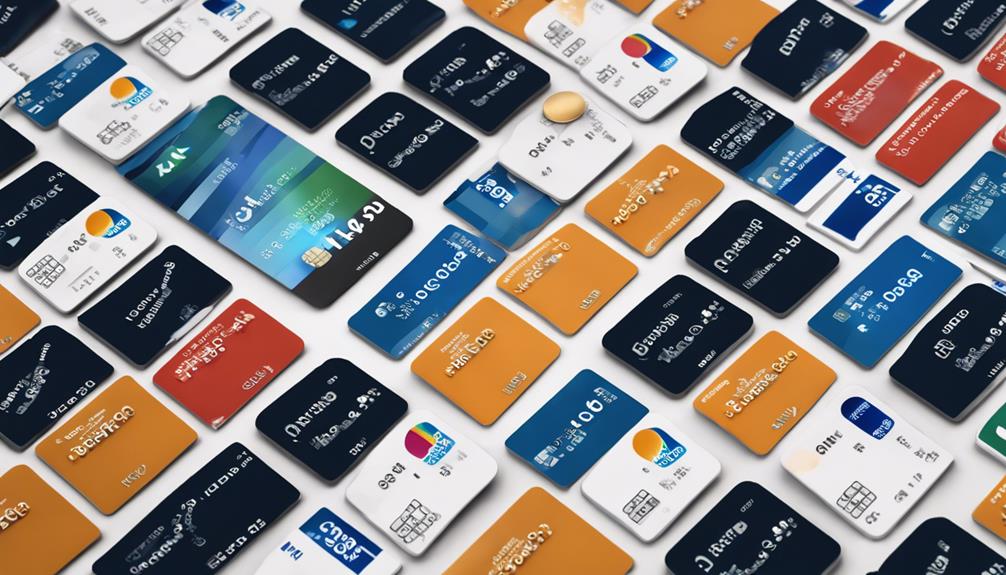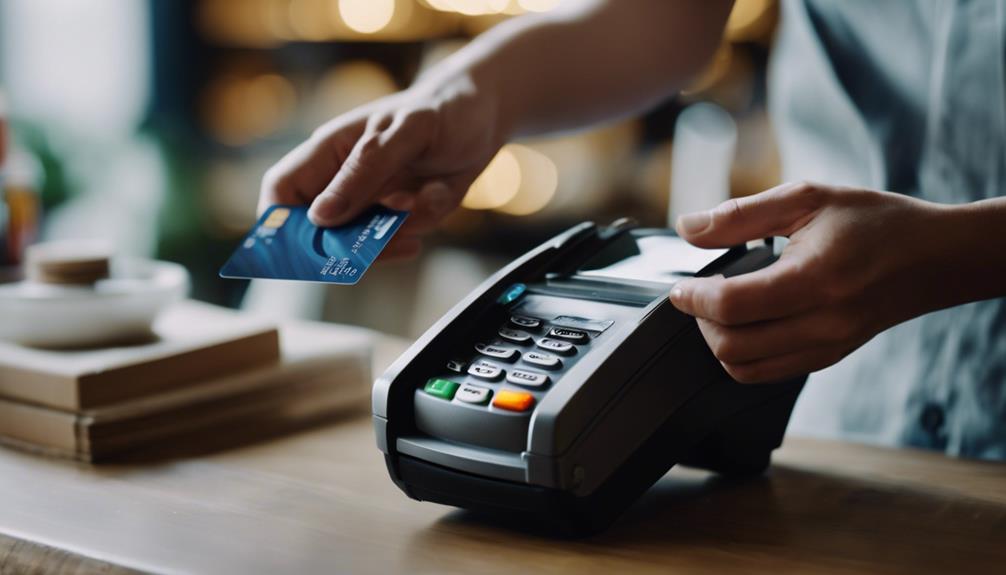Understanding interchange fees is essential for grasping the core of credit card processing costs. These fees, paid to card networks, are calculated based on transaction percentage and a fixed fee, impacted by card type and transaction specifics. Visa, Mastercard, and Discover all have varying interchange rates, affecting businesses differently. To optimize costs, negotiating with processors, implementing cash discount programs, and leveraging technology are key strategies. These approaches can help manage financial operations efficiently and potentially reduce expenses. Delving deeper into interchange fees allows for a more strategic approach to managing credit card processing costs effectively. For businesses, understanding the intricacies of interchange fees and how they impact credit card processing costs is crucial for financial success. By delving into the details of these fees, a clearer understanding can be gained of how to optimize and manage overall expenses. With credit card processing fees explained in detail, businesses can make informed decisions and take proactive steps to minimize costs and maximize profitability.
Key Takeaways
- Interchange fees are transaction costs paid to card networks.
- Fees vary based on card type, transaction method, and industry.
- Essential for managing costs and pricing strategies effectively.
- Negotiation, cash discounts, and technology can reduce interchange fees.
- Monitoring and optimizing interchange rates is crucial for financial efficiency.
What Are Interchange Fees?

Do you know what interchange fees are?
Interchange fees are transaction fees that businesses pay to card networks such as Visa and Mastercard for processing credit and debit card payments.
These fees are typically calculated as a percentage of the transaction amount along with a fixed fee. The exact interchange fee varies depending on factors like the type of card used, the method of the transaction, and the industry in which the business operates.
These fees cover a range of costs including card issuance, network maintenance, fraud prevention, and rewards programs. They're set by the card networks and play a significant role in determining the overall cost of accepting card payments for businesses.
Understanding interchange fees is essential for businesses to effectively manage costs, develop pricing strategies, and streamline their payment processing operations. By grasping the intricacies of interchange fees, businesses can make informed decisions that optimize their financial operations.
Calculating Interchange Fees

Understanding how interchange fees are calculated is crucial for businesses looking to optimize their financial operations and manage costs effectively.
To explore this further, consider the following key points:
- Card Type: Interchange fees vary depending on whether the card used is a rewards card, business card, premium card, or standard card.
- Transaction Method: The method through which a transaction is processed, whether it's card-present or card-not-present, can impact interchange fees.
- Merchant Category Code: Different industries are assigned specific merchant category codes that influence the interchange fees they incur.
- Transaction Size: The size of a transaction also plays a role in determining interchange fees, with larger transactions often attracting higher fees.
Visa Interchange Rates

Visa interchange rates for credit card transactions vary based on factors such as card type, industry, and transaction method. Debit card transactions typically have lower interchange rates on the Visa network compared to credit cards. Premium cards and commercial cards usually attract higher interchange fees. Visa interchange rates range from 0.05% + $0.22 to 1.99% + $0.10 per transaction. These fees support various cardholder benefits and network operations. Below is a table illustrating how Visa interchange rates can differ based on the card type, industry, and transaction method:
| Card Type | Industry | Transaction Method | Interchange Rate |
|---|---|---|---|
| Debit Cards | Retail | In-store | 0.05% + $0.22 |
| Credit Cards | Travel | Online | 1.99% + $0.10 |
| Premium Cards | Entertainment | Mobile | 1.50% + $0.15 |
| Commercial Cards | Healthcare | Recurring Payments | 1.70% + $0.12 |
| Rewards Cards | Education | E-commerce | 1.25% + $0.08 |
Mastercard Interchange Rates

When evaluating Mastercard interchange rates, businesses must consider a range of factors like card type, industry, and transaction method to effectively manage credit card processing costs. Understanding these rates is key to optimizing your expenses.
Here are some important points to keep in mind:
- Mastercard interchange rates can vary significantly, ranging from 0.05% + $0.10 to 2.60% + $0.10 per transaction.
- Debit card transactions typically carry lower interchange rates when processed through Mastercard.
- Premium cards and commercial cards often incur higher interchange fees on the Mastercard network.
- Interchange rates for Mastercard transactions are influenced by factors such as the type of card used, the industry of the business, and the method of the transaction.
Discover Interchange Rates

Discover interchange rates are essential to grasp for businesses handling credit card transactions. These rates depend on factors like card type and industry, typically ranging from 1.40% + 5¢ to 2.4% + 10¢ per transaction.
Interchange Rate Basics
Understanding the basics of interchange rates, particularly those set by the Discover network, is essential for managing your credit card processing expenses efficiently. Here are key points to keep in mind:
- Discover's interchange rates in the US typically range from about 1.40% + 5¢ to 2.4% + 10¢ per transaction.
- These rates are influenced by factors such as card type, transaction method, and industry.
- Discover's interchange fees, set by the network, directly impact the overall cost of credit card processing.
- Unlike Visa and Mastercard, Discover's interchange rates aren't publicly available, making it important for merchants to understand them to effectively control processing costs.
Factors Affecting Rates
To effectively manage your credit card processing costs, it's important to grasp the various factors that influence Discover's interchange rates.
Discover's interchange fees in the US typically range from about 1.40% + 5¢ to 2.4% + 10¢ per transaction, varying based on factors such as card type, transaction method, and business industry. The specific card used and the nature of the transaction also play a role in determining the interchange rates.
Different industries may encounter distinct interchange fee structures when processing payments through Discover. Understanding these nuances is essential for businesses looking to effectively manage costs associated with credit card processing.
American Express Interchange Rates

American Express's interchange fees in the US typically range from about 1.43% + 10¢ to 3.30% + 10¢ per transaction, varying based on card type, transaction method, and industry. Understanding these rates is essential for businesses to effectively manage costs.
Here are some key points to take into account:
- American Express's interchange fees are influenced by the type of card used for the transaction.
- The method through which the transaction is processed also plays a role in determining the interchange rates.
- Different industries may face varying interchange fees when processing American Express transactions.
- Compared to Visa and Mastercard, American Express generally imposes higher interchange fees, impacting the overall processing costs for businesses.
Interchange Pricing Models

When selecting a pricing model for credit card processing, businesses can choose between various options to determine how they'll be charged for each transaction.
The interchange plus pricing model offers transparency by showing the exact interchange fee along with a markup.
Tiered pricing models categorize transactions into different tiers based on criteria such as risk level.
On the other hand, flat-rate pricing charges a fixed fee per transaction, simplifying cost calculations for businesses.
The cost-plus pricing model bills businesses the exact interchange fee plus a markup, providing clarity on costs.
Understanding these different interchange pricing models can help businesses choose the most cost-effective option for their transactions.
By analyzing the nature of their transactions, businesses can select the pricing model that aligns best with their needs, whether they prioritize transparency, simplicity, or cost efficiency.
This decision plays an important role in managing credit card processing expenses efficiently.
Impact on Businesses

Interchange fees play a significant role in impacting businesses' operational costs, influencing pricing strategies and cash flow management when accepting card payments. Here are four key ways in which interchange fees can affect businesses:
- Operating Costs: Interchange fees can represent a substantial portion of a business's operating expenses, cutting into profit margins and affecting overall financial health.
- Pricing Strategies: Businesses may need to adjust their pricing strategies to accommodate interchange fees, potentially leading to changes in product pricing that could impact competitiveness in the market.
- Cash Flow Management: Interchange fees can impact cash flow management by introducing variability in transaction costs. This may prompt businesses to incentivize lower-cost payment methods or consider surcharging credit card transactions to offset these expenses.
- Payment Methods: Encouraging the use of debit cards or cash transactions, where feasible, can help mitigate the impact of interchange fees on businesses. Negotiating with payment processors and implementing best practices can also aid in reducing interchange fees and optimizing processing costs.
Strategies to Reduce Interchange Fees

To reduce interchange fees, you can start by negotiating with payment processors for potentially lower rates. Implementing cash discount programs can also encourage cash transactions and help in reducing interchange fees.
Additionally, exploring technology solutions that optimize transaction data can help qualify for lower interchange rates.
Negotiating With Processors
Consider leveraging your transaction volume and business history to negotiate lower interchange fees with processors. When negotiating with processors to reduce interchange fees, keep these strategies in mind:
- Provide accurate transaction data and showcase a low-risk profile.
- Explore interchange optimization solutions offered by processors.
- Maintain transparent communication regarding fee structures.
- Look into different pricing models and regularly review processing agreements for potential savings.
Implementing Cost-Saving Measures
Utilize cost-saving measures to strategically reduce interchange fees and optimize your payment processing expenses. Negotiate with payment processors to secure lower rates based on transaction volume and specific business requirements.
Implement cash discount programs to encourage cash transactions and decrease interchange fees associated with card payments. Leverage technology solutions such as point-of-sale systems that enhance interchange qualification criteria for potential cost savings.
Regularly monitor interchange fee structures to pinpoint areas for optimization and expense reduction. Additionally, consider adopting flat-rate pricing options to streamline fee structures and potentially lower interchange costs.
Frequently Asked Questions
What Is the Interchange Fee in Credit Card Processing?
In credit card processing, the interchange fee is a charge from merchants to card networks like Visa and Mastercard. It comprises a percentage of the transaction amount plus a fixed fee, determined by the card networks.
This fee covers expenses such as card issuance, network upkeep, and fraud prevention. Merchants can't negotiate these fees and they play an important role in processing costs.
Understanding interchange fees is essential for optimizing payment processing expenses.
What Factors Influence Interchange Fees?
Factors that influence interchange fees include:
- Card type
- Transaction method
- Merchant category code
- Transaction size
- Processing details
Rates vary for different types of cards:
- Rewards
- Business
- Premium
- Standard
There are differences for:
- Card-present transactions
- Card-not-present transactions
Various industries have varying risk levels, affecting interchange fees.
The calculation formula is complex and varies between card networks like:
- Visa
- Mastercard
- Discover
- American Express
Key determinants in interchange fee calculation include:
- Card brand
- Transaction volume
- Merchant category
- Payment network
What Are Interchange Fees for Card Based Payment Transactions?
Interchange fees for card-based transactions are fees exchanged between banks for processing credit and debit card payments. These fees, determined by card networks like Visa and Mastercard, compensate banks for card usage costs, fraud prevention, and rewards programs.
They can range from less than 1% for debit cards to up to 2.95% for specific credit card transactions. Understanding these fees is essential for businesses to manage payment processing costs effectively and make informed pricing decisions.
Do Banks Make Money From Interchange Fees?
Yes, banks do make money from interchange fees. They receive a portion of the fee paid by merchants for processing card transactions. These fees compensate banks for providing credit and debit cards to customers, covering operational costs, rewards programs, and fraud prevention measures.
The revenue earned from interchange fees varies based on the volume and value of card transactions processed, making them a significant income source for banks in the card payment ecosystem.
Conclusion
To sum up, interchange fees play a vital role in credit card processing costs for businesses. On average, interchange fees can range from 1.15% to 2.5% of each transaction amount, making them a significant expense for merchants.
Understanding how interchange fees are calculated and implementing strategies to reduce them can help businesses save money and improve their bottom line.
By staying informed and proactive, businesses can navigate the complex world of credit card processing more effectively.









